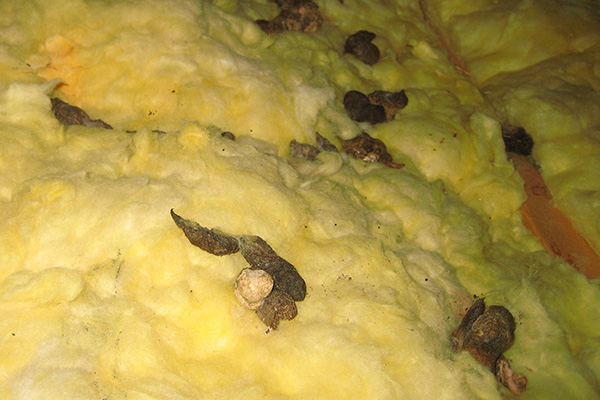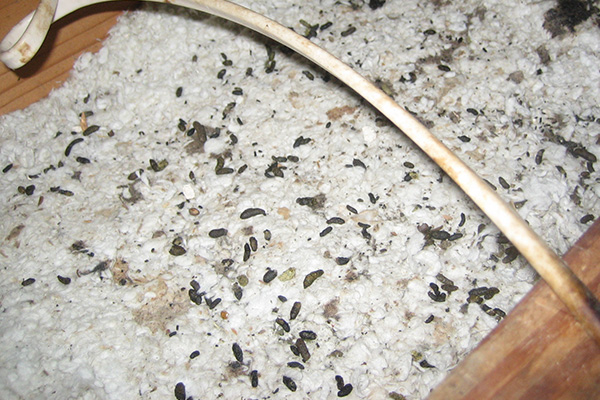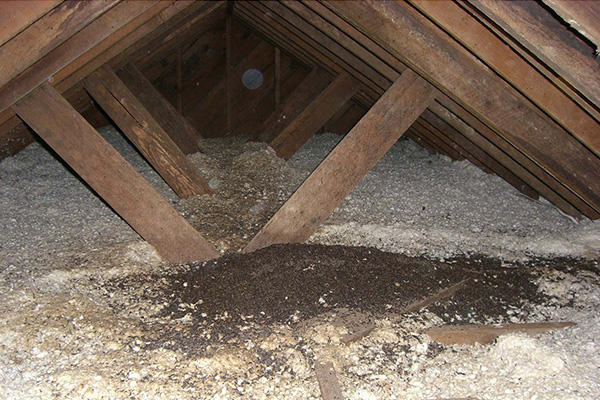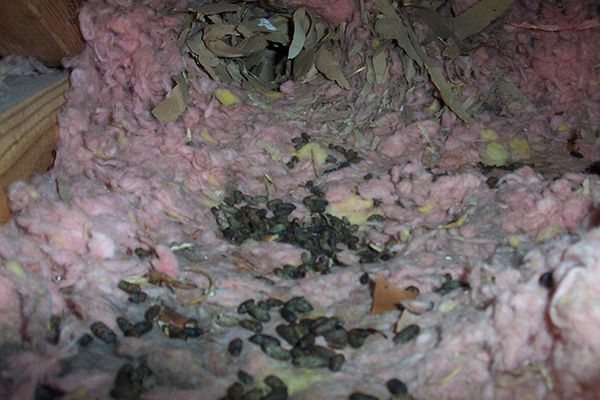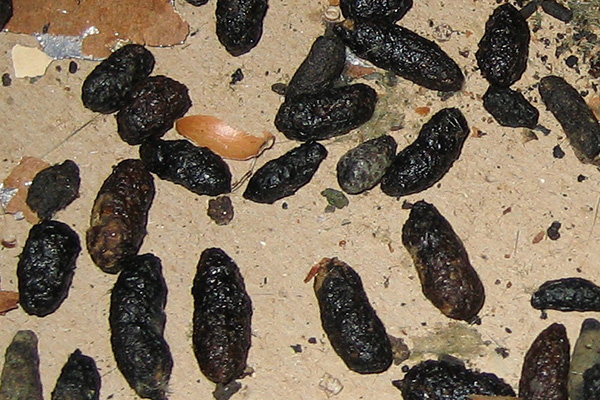- info@animalatticpest.com
- Call - we service 300 locations

Feces - How to Identify Animal Droppings in the Attic
When animals live in your attic, they always defecate and urinate, and they may leave a big mess behind. The droppings and urine can act as a vector for disease, such as Leptospirosis, salmonella infection, raccoon roundworm, hookworm,
Cryptosporidiosis, and more. Most of these are of lower risk, and only occur if feces is accidentally ingested or in some cases if dust is inhaled. Feces and urine can also be a fertile place for mold growth, which can cause harmful spores
or Histoplasmosis. Again, occurrence of these is rare, and depends largely on you interacting with the feces in the attic. But there are other reasons to clean the attic, such as odor issues. Even in you don't notice the odor, other animals
will, especially since animal waste often contains pheromones that attract other animals. Even the smell of rodent feces can attract snakes into the attic. Read more about Attic Restoration.
How to identify animal feces in your attic - an examination of the feces is the best possible way (other than spotting the animal) to identify exactly which species of animal you have in your attic. The best way to do so is to
look at the below photos. You can also click on the following web pages to see more photos, and get more info about the feces of these species: Squirrel Feces Photos, - Raccoon Feces Photos, -
Rat Feces Photos, - Mouse Feces Photos, - Bat Feces Photos, - Opossum Feces Photos.
Feces - How to Identify Animal Droppings in the Attic
Information About Feces - How to Identify Animal Droppings in the Attic
How To Identify Animal Droppings In The Attic
Finding animal droppings in your attic is one of the best ways to confirm that you have wildlife living there, with the exception of actually seeing the animal in question. While all animals will leave droppings in your attic if they spend enough time there, you can actually tell what type of wildlife is present based on the droppings in nearly every case. In those rare cases where you can’t tell for sure what type of animal it is, you will be able to narrow down your options to just one or two species.
Main Characteristics To Look For
To better understand how to identify animals based on their droppings in your attic, you need to know what factors to pay attention to. Appearance is clearly the most important factor, including the size, shape, and color. The color will vary greatly and if you look at photos, you will be impressed by the range of sizes and shapes as well. The quantity of feces present and how it is spread out can also help you identify the animal in question. Some animals will always go to the bathroom in the same spot while others will just do so wherever they are. Even the area of the attic the waste is in can give you hints, such as whether it is on the floor or rafters.
Identifying Squirrel Droppings
Since squirrels are among the most common animals to take up residence in your attic, you will want to know what their droppings look like. Their waste looks and smells different than that of other animals and is typically 3/8 of an inch in length with a diameter of up to 8 millimeters. It is an overall cylindrical shape featuring round edges. Due to the lack of diversity in their diets, squirrels typically have red or brown feces that will get lighter over time. The distribution is typically random, although you may find heavier concentrations in the area they typically feed.
And remember the difference between Squirrel Feces and Flying Squirrel Feces.
Identifying Bat Droppings
Bat droppings, known as guano, will have a shape similar to a grain of rice, but longer and if it is crushed, it becomes powder very easy, allowing for easier transmission of disease. You can tell their feces apart from that of rodents since it won’t harden and they may have undigested insects. It is not rare to find bat guano on the floor or walls. They typically leave waste in a single pile by where they rest or their entrance to your attic.
Identifying Mouse Droppings
Mouse droppings are recognizable by their appearance as well as their sheer number since a single mouse can leave 50 to 75 pellets each day. The droppings look similar to a seed and are between 1/8 and a ¼ of an inch. While they are typically tapered, they may be round. Their waste tends to be scattered throughout.
Identifying Rat Droppings
Like mouse droppings, roof rat feces will be randomly dispersed, but Norway rats tend to create small clusters. They tend to be soft and dark when fresh but the stool hardens over time and the color fades. The shape depends on the particular rat species but they are typically similar to raisins with a long, spindly shape. The average rat dropping is ¾ inches or less in length and ¼ inch thick. Norway rats tend to have larger, rectangular droppings while roof rats have smaller droppings with a shape like a curved sausage and tapered ends.
Identifying Raccoon And Possum Droppings
Raccoons tend to leave piles of waste that are similar to those of dogs. The pieces themselves are fat and you are likely to see some of the animal’s food, such as seeds. Possum dung is similar, but tends to have more of a curl. While possum dung typically is in a trail, raccoon feces will be in a single pile.
Identifying Chipmunk Droppings
If you see droppings that look similar to mouse feces, they may belong to a chipmunk. These tend to be hardened and about a ¼ inch larger than mouse droppings. If you suspect chipmunk waste, be particularly careful as they have a higher risk of spreading disease.
Identifying Lizard And Snake Droppings
Snake and lizard droppings are very similar to those of birds, making them sometimes hard to distinguish. When it is fresh, snake waste will be mushy and become chalky white as it dries so you need to decide if it is a snake or bird based on location. Lizard feces are dark and oblong like rat waste but has some white like you would find in bat guano.
Why Animal Droppings Pose A Risk
Most wildlife will transmit disease through their droppings so you need to always be cautious when near their waste. Rat droppings, for example, can carry rat-bite fever, salmonellosis, Hantavirus, or bubonic plague, although some are clearly much rarer than others. Bat guano has a serious risk of carrying histoplasmosis and should also be approached with caution, particularly since spores enter the area easily once it converts to powder. Read about mold in the attic that can come from feces.
Also, be especially aware of the accumulation of feces near a nest. Read about Nest in the Attic - How to Remove Nests in House. Because of the risks, you should always wear protective gear when cleaning or coming into contact with animal droppings in your attic.
The Bottom Line
Look at the above photos to identify what kind of animal droppings are in your attic. And whether you call them turds, poo, poop, droppings, feces, scat, shit, latrine, waste, whatever, it's usually a good idea to remove and clean it after you get the animals out of the attic.


